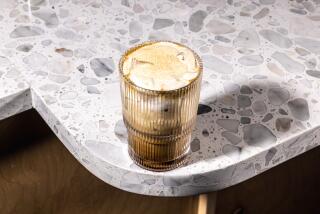Coffee Grounds : Back-Yard Gardener Brews Breakthrough
Renato L. Siong was browsing at a local nursery, looking for yet another tropical plant to add to the forest of fruits and vegetables growing in his back yard in Long Beach, when he saw a forlorn green pot tossed on a trash heap.
Siong, who was a professor of agriculture for 25 years in the Philippines, knew at first glance that the outcast was a coffee plant. The nursery had thrown it away because no one would buy it--naturally. Coffee only grows in tropical climes like the mountains of Colombia and the shores of Hawaii, not in smoggy, suburban Long Beach.
Wanna bet?
Siong took that plant and 19 others back to his Oregon Avenue house and planted them all over the yard three years ago to see if he could do the impossible--harvest coffee in Southern California as he had for 10 years in the Philippines, drying it, roasting it, grinding it, brewing it, drinking it and even selling the surplus to friends.
Several months later, the plant on the west side of the cluttered yard set beneath a skinny peach tree sprouted dozens of round green beans, proving that coffee does indeed grow in filtered Southern California sunlight and catapulting Siong to the revered position of Long Beach’s own Juan Valdez.
“Look at that!” Siong shrieked, holding a green leaf in his thick, weathered hand. “You do not have to go to Colombia to get those berries! Probably anybody here can grow coffee.”
The Arabica beans, which appeared with little fertilizer, morning shade and partial sun after 1 p.m., are said to be the most aromatic grade of coffee grown today. “The kind that wakes you up like this,” Siong said, sniffing the air.
There would seem to be a gold mine brewing considering the following: the coffee plant requires little care, its dark, shiny leaves bear a striking resemblance to the ficus tree and it sprouts delicate white flowers after bearing fruit.
At the same time, 52% of Americans drink an average of three cups of coffee a day, and gourmet, grind-your-own beans are practically a yuppie staple.
But Siong is not likely to publish what he believes is an agricultural breakthrough. His impressive credentials in the Philippines, where he earned a master’s degree in agricultural biochemistry and served as a consultant to the council on agriculture, are not recognized here, he said.
Siong, 51, works as a gardener for the Long Beach Unified School District and conducts his plant research in the cramped back yard of his home in North Long Beach, where he brought his wife and four children six years ago.
“Do these look like the hands of a professor of 25 years?” he asked, turning up two soiled and rugged palms. “Is that not something?”
He is a frustrated scholar full of ideas on how to grow fruits and vegetables uncommon to Southern California, although he claims they taste better and make more efficient use of the land. His yard overflows with hundreds of green pots and plowed plots of garlic, Japanese persimmons and macadamia nuts.
Kang kong, a plant similar to $3-a-pound watercress, grows with abandon and can be harvested every 29 days. Malungay, rich in vitamin A and used to flavor stews in the Philippines, costs more than a dollar here for four small cuttings but thrives near Siong’s back fence. Pommelo, like grapefruit but twice the size and with no bitter taste, hangs heavy from his small tree.
The coffee plant, however, is his pride and joy, although he has not yet tasted it. When the tree first bore fruit last year, Siong had no coffee grinder. So he threw the beans around the back yard.
This time, he plans to roast and grind them, and if his success in his native home is any indication, “it will be a cup of coffee as good as any grown in Colombia.”
High marks from a man who could surely be considered a coffee aficionado, if not for one small detail--he also drinks instant.






